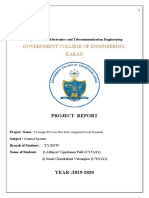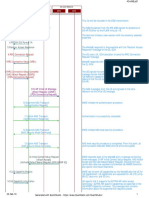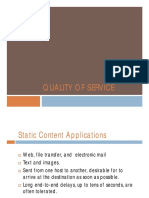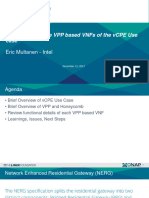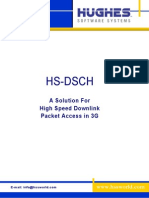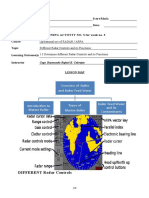GNB Interactions: 5G Standalone Access Registration: 1:Msg1: Preamble
GNB Interactions: 5G Standalone Access Registration: 1:Msg1: Preamble
Uploaded by
anujgujjarCopyright:
Available Formats
GNB Interactions: 5G Standalone Access Registration: 1:Msg1: Preamble
GNB Interactions: 5G Standalone Access Registration: 1:Msg1: Preamble
Uploaded by
anujgujjarOriginal Title
Copyright
Available Formats
Share this document
Did you find this document useful?
Is this content inappropriate?
Copyright:
Available Formats
GNB Interactions: 5G Standalone Access Registration: 1:Msg1: Preamble
GNB Interactions: 5G Standalone Access Registration: 1:Msg1: Preamble
Uploaded by
anujgujjarCopyright:
Available Formats
5G Standalone Access Registration gNB.
User Equipment 5G NodeB 5GC
UE gNB New AMF UPF
gNB Interactions: 5G Standalone Access Registration
5G-NR RRC Connection Setup
1:Msg1: Preamble The UE picks a random preamble. The preamble is referenced
Zadoff-Chu sequence with the Random Access Preamble Id (RAPID). The preamble
transmission is a Zadoff-Chu sequence.
2:Allocate Temporary C-RNTI The Temporary C-RNTI assignment will be signaled to the UE in
the Random Access Response message.
3:PDCCH DCI Format 1_0 [RA-RNTI] The RA-RNTI scrambled DCI message signals the frequency and
Frequency domain resource assignment, time resources assigned for the transmission of the Transport
Time domain resource assignment, Block containing the Random Access Response message.
Downlink MCS
4:Msg2: Random Access Response The UE detects a DCI Format 1_0 with CRC scrambled by the
Timing Advance Command, corresponding RA-RNTI and receives a transport block in a
UL Grant = { Frequency hopping flag, Msg3 PUSCH frequency+time resource corresponding PDSCH. The RAR carries the timing advance,
allocation, Uplink MCS, TPC command, CSI request}, uplink grant and the Temporary C-RNTI assignment.
Temporary C-RNTI
5:Msg3: RRCSetupRequest The RRC Setup Request is sent with the random ue-Identity and
ue-Identity, an establishment cause.
establishmentCause
6:PDCCH DCI Format 1_0 [C-RNTI] The C-RNTI scrambled DCI message signals the frequency and
Frequency domain resource assignment, time resources assigned for the transmission of the Transport
Time domain resource assignment, Block containing the RRC Setup message.
Downlink MCS
7:Setup SRB1 Signaling Radio Bearer 1 is configured.
8:Msg4: RRCSetup The RRC Setup message is sent to setup SRB1 and the master
radioBearerConfig {srb-ToAddModList}, cell. The message carries the radioBearerConfig and
masterCellGroup {cellGroupId, rlc-BearerToAddModList, mac-CellGroupConfig, masterCellGroup information elements.
physicalCellGroupConfig}
9:PDCCH DCI Format 0_0 [C-RNTI] The gNB assigns uplink resource to the UE so that it can send
Frequency domain resource assignment, the RRC Setup Complete message.
Time domain resource assignment,
Uplink MCS
13-Feb-19 Generated with EventStudio System Designer - https://www.EventHelix.com/EventStudio/ 1
5G Standalone Access Registration gNB.pdf
User Equipment 5G NodeB 5GC
UE gNB New AMF UPF
10:RRCSetupComplete The UE sends the RRC Setup Complete message with a
[dedicatedNAS-Message: Registration Request] "Registration Request" in the dedicatedNAS-Message field.
NAS Registration Request = {Registration type, 5G-GUTI, Last TAI, Requested
NSSAI, UE Capability, List of PDU Sessions}
11:AMF Selection The gNB selects the Access and Mobility Function (AMF) for this
session.
allocate The gNB allocates a "RAN UE NGAP ID". The AMF will use this id
12:RAN UE NGAP ID to address the UE context on the gNB.
13:NGAP Initial UE Message The gNB sends the Initial UE Message to the selected AMF. The
[NAS-PDU: Registration Request] message carries the "Registration Request" message that was
RAN UE NGAP ID,
received from the UE in the RRC Setup Complete message. The
NAS Registration Request = {Registration type, 5G-GUTI, Last TAI, "RAN UE NGAP ID" and the "RRC Establishment Cause" are also
Requested NSSAI, UE Capability, List of PDU Sessions}, included in the message.
User Location Information,
RRC Establishment Cause,
5G-S-TMSI,
AMF Set ID
14:NAS Identity Request The New AMF requests UE Identity (SUCI) from the UE via a NAS
Security header type, message.
Identity request message identity,
Identity type
15:NAS Identity Response The UE responds to the Identity Request.
Security header type,
Identity response message identity,
Mobile identity
NAS Authentication and Security
16:NAS Authentication Request Initiate the authentication procedure with the UE. Send the key
ngKSI, selector, RAND and AUTN to the UE.
RAND,
AUTN,
ABBA
17:NAS Authentication Response The UE responds to the authentication challenge.
Authentication response parameter
13-Feb-19 Generated with EventStudio System Designer - https://www.EventHelix.com/EventStudio/ 2
5G Standalone Access Registration gNB.pdf
User Equipment 5G NodeB 5GC
UE gNB New AMF UPF
18:NAS Security Mode Command The AMF signals the selected NAS security algorithm to the UE.
Selected NAS security algorithms, The AMF also requests the IMEISV from the UE.
Replayed UE security capabilities,
IMEISV request,
ngKSI,
Additional 5G security information
19:NAS Security Mode Complete The UE signals the completion of the NAS security procedure.
NAS message container, The message contains the IMEISV.
IMEISV
20:Initial Context Setup Request The AMF initiates a session setup with the gNB. The message
[NAS-PDU: Registration Accept] typically contains the Registration Accept NAS message. The
AMF UE NGAP ID,
message carries one or more PDU Session setup requests. Each
RAN UE NGAP ID, PDU session is addressed with the "PDU Session ID". The
UE Aggregate Maximum Bit Rate, message also carries the uplink TEID for every PDU session.
GUAMI,
PDU Session Resource Setup Request List,
PDU Session ID,
PDU Session Uplink TEID,
UE IP Address,
NAS-PDU,
S-NSSAI,
PDU Session Resource Setup Request Transfer,
Allowed NSSAI,
UE Security Capabilities,
Security Key
The message also carries the "AMF UE NGAP ID", "UE Aggregate
Maximum Bit Rate", UE security capabilities and security key.
5G-NR AS Security Procedure
21:SecurityModeCommand
securityConfigSMC {securityAlgorithmConfig}
22:SecurityModeComplete The security mode complete message confirms the successful
completion of the security mode command. This message is
integrity protected but not ciphered. Ciphering will start
immediately after sending this message.
5G-NR RRC Reconfiguration
13-Feb-19 Generated with EventStudio System Designer - https://www.EventHelix.com/EventStudio/ 3
5G Standalone Access Registration gNB.pdf
User Equipment 5G NodeB 5GC
UE gNB New AMF UPF
23:RRCReconfiguration The RRC Reconfiguration message is sent to the UE for setting
[Registration Accept up radio bearers, setup a secondary cell and initiate UE
(5GS registration result, measurements.
PDU session status)]
masterCellGroup,
secondaryCellGroup,
radioBearerConfig (drb-ToAddModList),
MeasConfig (Measurement Config)
24:RRCReconfigurationComplete Confirm the successful completion of an RRC connection
uplinkTxDirectCurrentList [ {servCellIndex, uplinkDirectCurrentBWP}] reconfiguration.
allocate Allocate the TEID that the UPF will use to send downlink data to
25:PDU Session Downlink TEID the gNB.
26:Initial Context Setup Response The gNB signals the successful setup of PDU sessions. The
PDU Session Downlink TEID message also carries the Downlink TEID that should be used
(specified per PDU session).
27:NAS Registration Complete The UE signals the completion of the registration via the
"Registration Complete" message to the AMF.
Start Downlink and Uplink Data Transfer
28:Uplink Data Since the uplink path has been setup completely, the UE starts
UTEID sending data. The gNB sends the UE data to the Uplink TEID.
29:Downlink Data The UPF sends the buffered data to the gNB using the Downlink
DTEID
TEID for the PDU session. All new downlink data also takes the
same path.
13-Feb-19 Generated with EventStudio System Designer - https://www.EventHelix.com/EventStudio/ 4
You might also like
- Mobile Codes IndiaDocument304 pagesMobile Codes Indiaanujgujjar80% (5)
- Network Security All-in-one: ASA Firepower WSA Umbrella VPN ISE Layer 2 SecurityFrom EverandNetwork Security All-in-one: ASA Firepower WSA Umbrella VPN ISE Layer 2 SecurityNo ratings yet
- 5G NR RACH Procedure Overview - CBRA & CFRA - 5G MACDocument4 pages5G NR RACH Procedure Overview - CBRA & CFRA - 5G MACAli SerunjogiNo ratings yet
- 1-AoIP Networking and Principle ISSUE1.00Document61 pages1-AoIP Networking and Principle ISSUE1.00JosephGrégoireFayeNo ratings yet
- I. RRC Connection Re-Establishment ProcedureDocument4 pagesI. RRC Connection Re-Establishment ProcedureahlemNo ratings yet
- Low Pass Filter ReportDocument9 pagesLow Pass Filter Reportsumit valsangkar100% (1)
- UE Interactions: 5G Standalone Access Registration: 2:Msg1: PreambleDocument5 pagesUE Interactions: 5G Standalone Access Registration: 2:Msg1: PreambleSumit SaxenaNo ratings yet
- 5G Stand Alone Access RegistrationDocument7 pages5G Stand Alone Access RegistrationSonny MochamadNo ratings yet
- En DC Secondary Node Addition Core Network DetailsDocument6 pagesEn DC Secondary Node Addition Core Network DetailsTalent & Tech Global Infotech100% (1)
- 5G-NR Non-Standalone Access (With EPC Flow) En-Dc-Secondary-Node-Addition-Core-Network-Details PDFDocument6 pages5G-NR Non-Standalone Access (With EPC Flow) En-Dc-Secondary-Node-Addition-Core-Network-Details PDFSourabh Kumar Jain100% (1)
- En DC Secondary Node AdditionDocument6 pagesEn DC Secondary Node AdditionWaqas KhanNo ratings yet
- Ue PDFDocument3 pagesUe PDFAndre LuizNo ratings yet
- Lte x2 Handover RRC Signaling FlowDocument1 pageLte x2 Handover RRC Signaling FlowLeuLeuNo ratings yet
- 3G Moc Signaling Message PDFDocument2 pages3G Moc Signaling Message PDFMuhammad RizkiNo ratings yet
- 4G Architecture With Interfaces and ProtocolsDocument8 pages4G Architecture With Interfaces and Protocolsteam DinnerNo ratings yet
- 4G eNB PDFDocument3 pages4G eNB PDFHeribertus BudhihartoNo ratings yet
- FPGA Implementation of A FEC DecodingDocument6 pagesFPGA Implementation of A FEC DecodingPavel SchukinNo ratings yet
- Lte Attach PDFDocument6 pagesLte Attach PDFNitin KatariaNo ratings yet
- LTE Accessibility Opitimization GuideDocument57 pagesLTE Accessibility Opitimization Guidesatya vara prasad balla100% (1)
- Final 2017-2018Document7 pagesFinal 2017-2018رمقالحياةNo ratings yet
- Caini 2006Document5 pagesCaini 2006Thanh Dao TuanNo ratings yet
- Ht808it23 ScopeDocument29 pagesHt808it23 ScopeKhaled OmarNo ratings yet
- 5G NR Radio Network Temporary IdentifierDocument7 pages5G NR Radio Network Temporary IdentifierOscar DazaNo ratings yet
- LTE Rach ProcedureDocument4 pagesLTE Rach ProcedureDeepak JammyNo ratings yet
- PDCCHDocument8 pagesPDCCHSaahil MathewsNo ratings yet
- 3g Umts Terminating CallDocument5 pages3g Umts Terminating Callsajjad.ashrafzadehNo ratings yet
- ITCE 720A Autonomic Wireless Networking (Fall, 2009)Document24 pagesITCE 720A Autonomic Wireless Networking (Fall, 2009)Souhila SelmaNo ratings yet
- LTE Attach and Default Bearer Setup: Random Access ProcedureDocument4 pagesLTE Attach and Default Bearer Setup: Random Access ProcedureChetan BhatNo ratings yet
- Lte Attach PDFDocument4 pagesLte Attach PDFAdnanNo ratings yet
- LTE AttachDocument4 pagesLTE AttachRajib ChowdhuryNo ratings yet
- LTE Attach and Default Bearer Setup: Random Access ProcedureDocument4 pagesLTE Attach and Default Bearer Setup: Random Access Procedurealemayehu w. teferaNo ratings yet
- LTE Training Day 6 - Protocol Stacks & SignallingDocument143 pagesLTE Training Day 6 - Protocol Stacks & SignallingMohammed AbdullahNo ratings yet
- MGCP v1Document1 pageMGCP v1aiorNo ratings yet
- 2Way-Sat: A DVB-RCS Satellite Access NetworkDocument8 pages2Way-Sat: A DVB-RCS Satellite Access Networktripleplay3636No ratings yet
- 02 5G PDCCH & PUCCH Resource ManagementDocument19 pages02 5G PDCCH & PUCCH Resource Managementgulzar.rf1991No ratings yet
- Lte x2 Handover Ue InteractionsDocument2 pagesLte x2 Handover Ue InteractionsLeuLeuNo ratings yet
- 5G NR ProtocolsDocument17 pages5G NR ProtocolsrajeevNo ratings yet
- D1 - 04 - Iago Alvarez - TCP and Automotive Ethernet - How To Resolve The Everlasting StruggleDocument24 pagesD1 - 04 - Iago Alvarez - TCP and Automotive Ethernet - How To Resolve The Everlasting StruggleAlberto AbarcaNo ratings yet
- N Ext G Eneration S DHDocument28 pagesN Ext G Eneration S DHAbdou Saïd Akambi PhilippeNo ratings yet
- Transmitting Video-on-Demand EffectivelyDocument5 pagesTransmitting Video-on-Demand EffectivelyUniversal Journal of Computer Science and Engineering TechnologyNo ratings yet
- Software Defined Radio Implementation of A DVB S Transceiver PaperDocument5 pagesSoftware Defined Radio Implementation of A DVB S Transceiver PaperLalchand MangalNo ratings yet
- N Ext G Eneration S DHDocument28 pagesN Ext G Eneration S DHSudip MondalNo ratings yet
- CCNA Training CCNAv7 (2020) - New Questions Part 5Document29 pagesCCNA Training CCNAv7 (2020) - New Questions Part 5Narcis IlieNo ratings yet
- IoT in Five Days - v1.1 20160627 (1) - 1-160-128-136Document9 pagesIoT in Five Days - v1.1 20160627 (1) - 1-160-128-136pham phuNo ratings yet
- 1 Compare I-TCP, S-TCP and M-TCP 2 Understand CO3: Assignment # 2Document8 pages1 Compare I-TCP, S-TCP and M-TCP 2 Understand CO3: Assignment # 2wexidaNo ratings yet
- Medium Access ProtocolDocument8 pagesMedium Access Protocolsrinivassasikumar1987No ratings yet
- Jbptunikompp GDL Sindrianil 19463 9 10.qosDocument34 pagesJbptunikompp GDL Sindrianil 19463 9 10.qosTugas UtomoNo ratings yet
- Ericsson LTE FDD SchedulingDocument37 pagesEricsson LTE FDD Schedulingsameh shebl100% (2)
- d-3924 MGCP CCM TRACE Nov08Document23 pagesd-3924 MGCP CCM TRACE Nov08acanalog202402No ratings yet
- Configuring Cisco Discovery ProtocolDocument6 pagesConfiguring Cisco Discovery ProtocolDenisNo ratings yet
- vCPE VPP VNF Deep DiveDocument15 pagesvCPE VPP VNF Deep Divest.andrews.eveNo ratings yet
- HS DSCH WP 04Document10 pagesHS DSCH WP 04api-3743621No ratings yet
- SENIC: Scalable NIC For End-Host Rate LimitingDocument14 pagesSENIC: Scalable NIC For End-Host Rate LimitingXANPHOXYL KIBETNo ratings yet
- Performance Analysis of Slotted CSMA/CA IEEE 802.15.4 With Heterogeneous No-Acknowledged Uplink TrafficDocument5 pagesPerformance Analysis of Slotted CSMA/CA IEEE 802.15.4 With Heterogeneous No-Acknowledged Uplink TrafficWalter GroteNo ratings yet
- Onboard Data Handling and TelemetryDocument65 pagesOnboard Data Handling and TelemetryDavid Diaz RivasNo ratings yet
- 22 Attach FlowfffDocument48 pages22 Attach FlowfffDharamveer Singh100% (1)
- MediaTek White Paper R17 5GDocument16 pagesMediaTek White Paper R17 5Gchieh1280No ratings yet
- 5G Mobility OverviewDocument72 pages5G Mobility Overviewwaelq2003No ratings yet
- 847 C3 FrameRelayDocument33 pages847 C3 FrameRelayVictor Axel Sagñay LNo ratings yet
- CISCO PACKET TRACER LABS: Best practice of configuring or troubleshooting NetworkFrom EverandCISCO PACKET TRACER LABS: Best practice of configuring or troubleshooting NetworkNo ratings yet
- 4G Layer 2 MessageDocument6 pages4G Layer 2 MessageanujgujjarNo ratings yet
- UMTS and Data Services - 1st Quarter 2008: Total Market Unidade 1Q07 2Q07 3Q07 4Q07 1Q08Document6 pagesUMTS and Data Services - 1st Quarter 2008: Total Market Unidade 1Q07 2Q07 3Q07 4Q07 1Q08anujgujjarNo ratings yet
- 2015CustomerTrainingCatalog CourseDescriptions (WCDMA)Document218 pages2015CustomerTrainingCatalog CourseDescriptions (WCDMA)anujgujjarNo ratings yet
- OWG007101 IGWB Hardware and Principle ISSUE 1.0Document35 pagesOWG007101 IGWB Hardware and Principle ISSUE 1.0anujgujjarNo ratings yet
- MML Reference and Parameter ReferenceDocument9 pagesMML Reference and Parameter ReferenceTahir Hussain100% (2)
- Data Configuration DescriptionDocument5 pagesData Configuration DescriptionanujgujjarNo ratings yet
- Vacancy Format After IVth Counselling - UpdateDocument2 pagesVacancy Format After IVth Counselling - UpdateanujgujjarNo ratings yet
- ALM-21814 BSS Internal Voice Channel AbnormalDocument2 pagesALM-21814 BSS Internal Voice Channel Abnormalanujgujjar100% (1)
- ALM-21814 BSS Internal Voice Channel AbnormalDocument2 pagesALM-21814 BSS Internal Voice Channel Abnormalanujgujjar100% (1)
- Huawei 3G Alarm CorrelationDocument1 pageHuawei 3G Alarm Correlationanujgujjar50% (2)
- All in One ScriptDocument22 pagesAll in One ScriptanujgujjarNo ratings yet
- Basic LTE CommandsDocument2 pagesBasic LTE Commandsanujgujjar100% (1)
- Tandberg EN8090Document3 pagesTandberg EN8090anujgujjarNo ratings yet
- 0203 2009 Proj UpdateDocument4 pages0203 2009 Proj UpdateanujgujjarNo ratings yet
- EE 210 Frequency Response Lab Supplement: DV (T) I (T) C DTDocument3 pagesEE 210 Frequency Response Lab Supplement: DV (T) I (T) C DTAlbert Cereno SerranoNo ratings yet
- Ctia Ota Test Plan 3 8 2Document628 pagesCtia Ota Test Plan 3 8 2Sub FireNo ratings yet
- 8697 Specimen ChartsDocument32 pages8697 Specimen Chartsmostafanasr23897No ratings yet
- Strahlenfolter - TI - How To Detect Electronic Harassment Easy - Targeted Individuals - YoutubeDocument44 pagesStrahlenfolter - TI - How To Detect Electronic Harassment Easy - Targeted Individuals - YoutubeTimo_KaehlkeNo ratings yet
- 31 Pdfsam SICAM T 7KG966 US PDFDocument1 page31 Pdfsam SICAM T 7KG966 US PDFAhmad Rofiq SofyanNo ratings yet
- PPL Chapter 5 NotesDocument5 pagesPPL Chapter 5 NotesRaph 1123No ratings yet
- 3rd Quarter Assessment Science 7Document7 pages3rd Quarter Assessment Science 7Ma Fatima AbacanNo ratings yet
- Presentation On Li-Fi (Light Fidelity) The Future Technology in Wireless CommunicationDocument28 pagesPresentation On Li-Fi (Light Fidelity) The Future Technology in Wireless CommunicationJinal Dhobi33% (3)
- Np70 - West Indies Pilot Vol.1 Ed.2003Document361 pagesNp70 - West Indies Pilot Vol.1 Ed.2003Pricop Marius OctavianNo ratings yet
- Coherent MIMO Radar The Phased Array and Orthogonal WaveformsDocument16 pagesCoherent MIMO Radar The Phased Array and Orthogonal WaveformsPriyaSbmNo ratings yet
- Service Manual: 50" LCD TV Chassis PL12.4Document85 pagesService Manual: 50" LCD TV Chassis PL12.4Javier CaviedesNo ratings yet
- Radioddity QR20 User Manual - Digital Version - 20210527Document27 pagesRadioddity QR20 User Manual - Digital Version - 20210527G MNo ratings yet
- Effer - Dmu 3000 Plus-Operator ManualDocument66 pagesEffer - Dmu 3000 Plus-Operator ManualPawełNo ratings yet
- Learning Module NAV 5 - Operational Use of RADAR - ARPA LO No. 1.3Document15 pagesLearning Module NAV 5 - Operational Use of RADAR - ARPA LO No. 1.3Frednixen Bustamante GapoyNo ratings yet
- PMP 450 Technical Training - Q3-2019 - v1.2Document152 pagesPMP 450 Technical Training - Q3-2019 - v1.2john villamilNo ratings yet
- Orbcomm Satellite SystemDocument23 pagesOrbcomm Satellite SystemNabil Magdi HasanNo ratings yet
- C346 Low Audio: Na OnlyDocument1 pageC346 Low Audio: Na OnlyMatasaru Alexandru DumitruNo ratings yet
- NastlogDocument6 pagesNastlogrameshNo ratings yet
- Instalasi Wan-Satelit: Band Designation Frequencyrange UsageDocument13 pagesInstalasi Wan-Satelit: Band Designation Frequencyrange UsageFajar Dwi JayantoNo ratings yet
- NCT-196 SetupDocument2 pagesNCT-196 SetupMichael KarantziasNo ratings yet
- Frequency Display and VFO Stabilizer: Eliminates Frequency Drift in Home-Brew and Surplus' HF ReceiversDocument6 pagesFrequency Display and VFO Stabilizer: Eliminates Frequency Drift in Home-Brew and Surplus' HF ReceiversedosviracNo ratings yet
- 5G NSA Call Drop Failures Possible Causes Troubleshooting Methods 1Document17 pages5G NSA Call Drop Failures Possible Causes Troubleshooting Methods 1engrr_harisNo ratings yet
- Nama:Muhamad Kastono Kelas: DP Iv Nautik: A. Circle The Correct Verb TenseDocument4 pagesNama:Muhamad Kastono Kelas: DP Iv Nautik: A. Circle The Correct Verb TenseLutianaNo ratings yet
- Application of Dijkstra'sAlgorithm in Wireless Communication SystemDocument6 pagesApplication of Dijkstra'sAlgorithm in Wireless Communication SystemIJRASETPublicationsNo ratings yet
- VHF Radiotelephone: FM-8800D/8800SDocument129 pagesVHF Radiotelephone: FM-8800D/8800SHikmat RahimovNo ratings yet
- Đề 9 6 BảnDocument6 pagesĐề 9 6 BảnthuytopppNo ratings yet
- Kuh Radio PDFDocument98 pagesKuh Radio PDFRade ČikarićNo ratings yet
- And 300 Mili Amp Is Used For Incomer FeederDocument2 pagesAnd 300 Mili Amp Is Used For Incomer FeederRadheshyam RaiNo ratings yet
- Sux6 71a PDFDocument3 pagesSux6 71a PDFXaha AhaNo ratings yet





